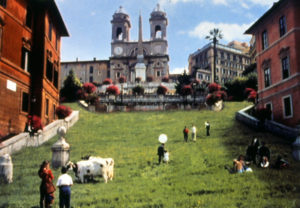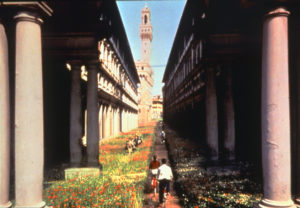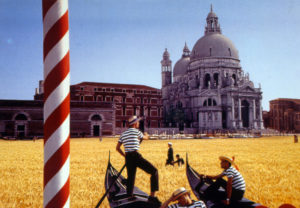Nature in the City

by Emmanuel Grossi
Alberto Baccari is not the man you expect to see. Most of all, he is not the type of man you expect to see inside the offices of the Armando Testa agency of Turin, leading the advertising communication of Mulino Bianco. In the collective imagination, he is the typical non-conformist artist, constantly travelling (especially between New York and Milan), with an open multicultural mentality, and a professional level that makes him esteemed abroad, and little known in his own country.
He recalls that at the agency, that in many aspects had remained formally a local establishment of Turin, people looked at him sideways, as if he was an unpredictable element. However, he was the right person to steer the advertising campaigns of Mulino Bianco in the direction of a glamorous, modern and international character, as this remained still naïve and provincial with respect to Barilla pasta.
In the mid-1980s, together with the mythical Armando, he founded the New York offices of the agency. Then at Armando’s death in 1992, with his son Marco taking over, he went back to being a freelance professional. However, it was Marco, just about a year later, to look for him and to reach him in the States to propose a new collaboration on new creativity to him.
Alberto recalls that the idea that moved him was very simple: in recent years, advertising communication (with the family in Chiusdino) had shown humanity going towards nature, following a trend with a social impact that would reveal to be more modest than had been foreseen. Then, why not turn over the relationship and why not show nature that, if respected and appreciated (in nutrition as well) meets humanity to reach it in its everyday life in the city?
Nature in the City was created this way. A new amazing campaign showed the historical urban centers of Florence, Rome and Venice invaded by blonde grain. It debuted on television and cinema screens in 1994 and won for Mulino Bianco its first international awards, reaching the high point with a Bronze Lion at the International Advertising Film Festival of Cannes in 1995.
As an Italian proverb says, surely never as before, between words and deeds there is an ocean. Better, there were oceans. There was the Atlantic Ocean, which Alberto flew over back and forth until his moving to Turin. Then there was the Indian Ocean, from which came film director Tarsem (Tarsem Dhandwar Singh his full name), though by the time he had moved to the Western world, and who became so enthusiastic about the project that he finally accepted to work for the Italian market. The English Channel, was crossed several times to entrust the extremely complicated post production to the leading international society The Mill of London. Lastly, there was the joining of two oceans in South Africa, where later on the fields of ripe wheat were filmed (out of season in our hemisphere), to integrate the filming that was made in Italy.
Alberto Carloni, who at the time was head of the cinema office of the agency, recalls that the shooting lasted for weeks to obtain a perfect result, which was a thing not to be taken for granted at all, since it was the first time that the motion control technique was used in Italy to such a degree of complexity.
Once the low budget idea to use cartoons was abandoned, in order to film the most realistic overlap of the fields with the city locations of Piazza Santa Croce, Piazza della Signoria, Ponte Vecchio, the Cortile degli Uffizi and Santa Maria del Fiore (Florence), Piazza del Pantheon, Piazza di Spagna, Piazza Navona, the Campidoglio, Fontana di Trevi and the Colosseo (Rome), Piazza San Marco, the Ponte dei Sospiri, the Ponte di Rialto and Santa Maria della Salute (Venice), it was necessary not only to replicate shots and motions of the camera, but also to plan the timing of shooting so that in the scenes the sun would shine at always the same angle…
To further enhance all this, nostalgic musical selections were chosen (another elegant feature by Baccari): Parlami d’amore, Mariù by Vittorio De Sica for Florence, Quel che non si fa più by Charles Aznavour for Venice and O mio babbino caro from the opera Gianni Schicchi by Puccini for Rome. This latter opera aria caused a bit of a war: Baccari recalls that he and Tarsem wanted to use the version sung by Maria Callas, while the Barilla Company preferred Renata Tebaldi (who moreover was a former student of the Conservatory of Parma and who elected Langhirano as her home). In the end, both versions were edited, but for the airing, Angel Voice (Tebaldi) won over the Divina (Callas)…


